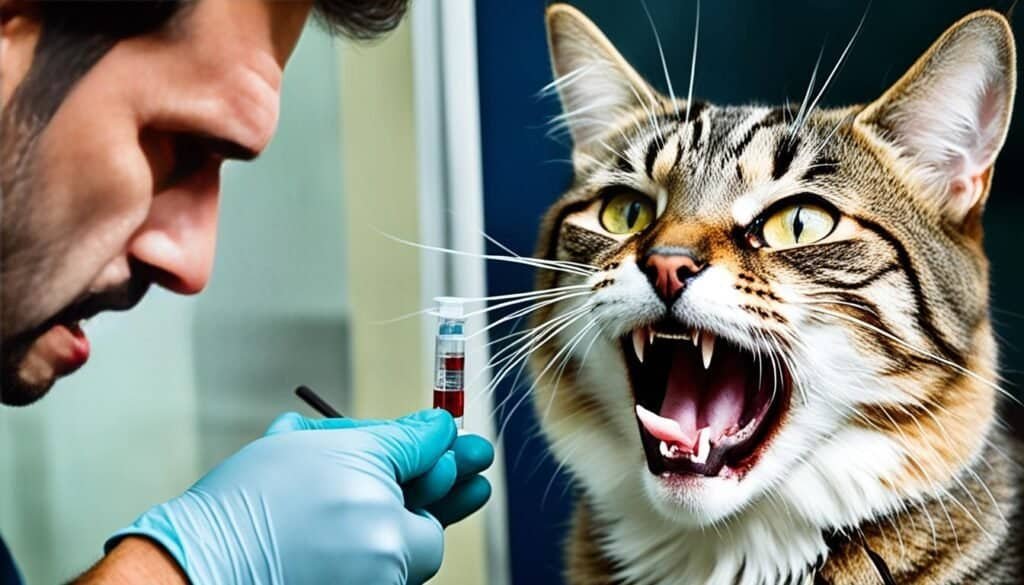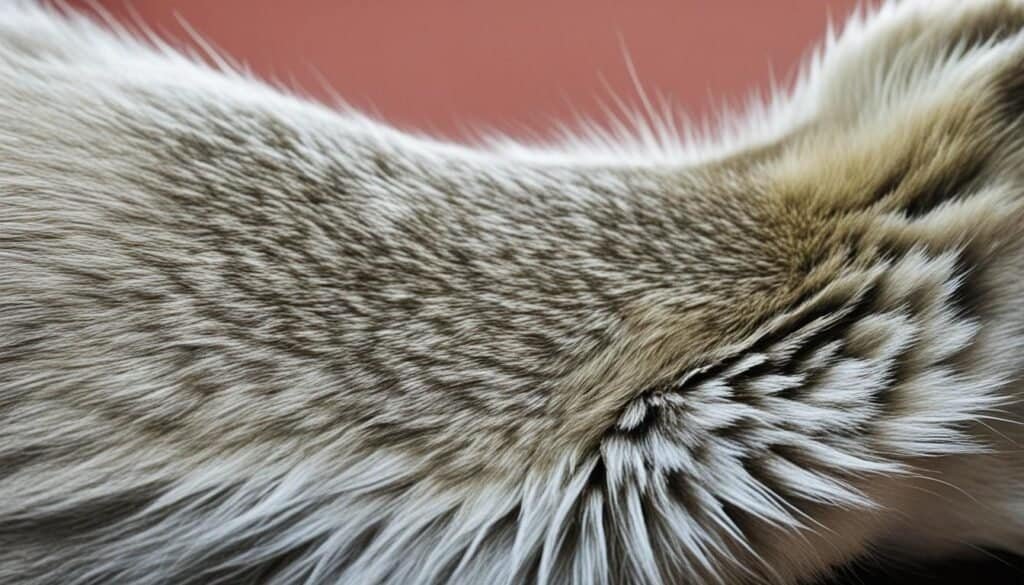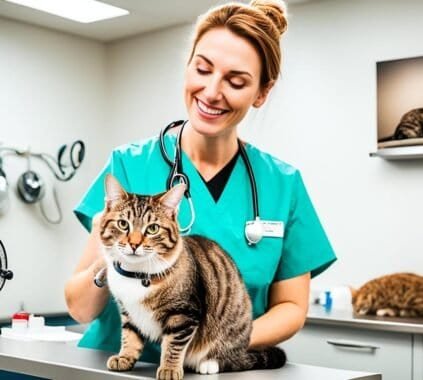From feline health problems to cat common illnesses, there is a range of prevalent cat health conditions that every cat owner should be familiar with. By gaining knowledge about these cat sicknesses, owners can ensure that their cats receive the proper care and prompt treatment they need.
Cats are beloved companions for many people in the Philippines, providing endless joy and companionship. However, just like humans, cats can experience health issues and fall ill. It is crucial for cat owners to be aware of the common illnesses that can affect their feline friends and to understand how to recognize the signs of illness.
Key Takeaways:
- Understanding common cat illnesses is essential for cat owners in the Philippines.
- Cats can be prone to various health issues, and early recognition is key.
- Being aware of the most common cat diseases helps in providing adequate care and treatment.
- Regular veterinary check-ups and attentive care are crucial for maintaining cat health.
- By staying informed and proactive, cat owners can ensure the well-being of their feline companions.
Different Types of Cat Diseases
When it comes to the health of our beloved feline companions, being aware of the different types of cat diseases is crucial. In the Philippines, cats are susceptible to various illnesses that can affect their well-being. Understanding these common cat illnesses is essential for cat owners in order to provide the necessary care and treatment.
Here are some prevalent feline health conditions that cat owners should be familiar with:
- Diabetes: Diabetes in cats is characterized by the body’s inability to produce or utilize insulin effectively, resulting in high blood sugar levels. Symptoms may include increased thirst, frequent urination, weight loss, and lethargy.
- Kidney Diseases: Cats, especially older ones, are prone to kidney diseases. These conditions can be caused by various factors, including infections, toxins, or genetic predispositions. Symptoms may include increased thirst, decreased appetite, weight loss, and changes in urine output.
- FIV and HIV: Feline Immunodeficiency Virus (FIV) and Feline Immunodeficiency Virus (HIV) are viral infections that affect a cat’s immune system. FIV is primarily transmitted through deep bite wounds, while HIV is passed on from an infected mother to her kittens. Both diseases weaken the immune system, making cats more susceptible to other infections.
- Leukemia: Feline Leukemia Virus (FeLV) is a contagious disease that can lead to the development of various forms of cancer in cats. It is primarily transmitted through close contact with infected cats or sharing of contaminated items. Symptoms may include weight loss, anemia, fever, and recurrent infections.
- Rabies: Rabies is a viral disease that affects the central nervous system and can be transmitted to cats through bites from infected animals. It is a serious condition that can be fatal to both cats and humans. Symptoms may include aggression, excessive drooling, difficulty swallowing, and paralysis.
- Heartworm: Cat heartworm disease is caused by parasitic worms that primarily affect the heart and lungs. Mosquitoes are responsible for transmitting heartworm larvae to cats. Symptoms may include coughing, difficulty breathing, weight loss, and lethargy.
- Hyperthyroidism: Hyperthyroidism is a hormonal disorder that occurs when a cat’s thyroid gland overproduces thyroid hormones. It is commonly seen in older cats and can lead to weight loss, increased appetite, restlessness, and vomiting.
Knowing the symptoms and understanding the treatment options for these common cat diseases is essential for cat owners. Regular visits to the veterinarian, proper vaccination protocols, and a healthy lifestyle can help prevent and manage these feline health conditions.
Diabetes in Cats
Diabetes is a common illness in cats, especially those who are overweight or obese. It is characterized by the inability to produce sufficient levels of insulin, resulting in high blood sugar levels.
Symptoms of diabetes in cats include:
- Increased thirst
- Excessive urination
- Rapid weight loss
- Vomiting
Treatment for feline diabetes usually involves a combination of a special diet, oral medications, and in some cases, insulin therapy as prescribed by a veterinarian.
“Early diagnosis and proper management are crucial in managing diabetes in cats and improving their quality of life,” says Dr. Maria Santos, a veterinarian specializing in feline health.
“Monitoring blood sugar levels, ensuring a balanced diet, and administering medications or insulin under veterinary guidance are key in controlling the disease.”
| Treatment | Description |
|---|---|
| Dietary Management | A specialized diet that helps regulate blood sugar levels and control weight. High-protein, low-carbohydrate diets are often recommended. |
| Oral Medications | Medications such as glipizide may be prescribed to stimulate insulin production or increase the body’s sensitivity to insulin. |
| Insulin Therapy | In cases where cats cannot regulate blood sugar levels with diet and oral medications, insulin injections may be necessary. Regular monitoring of blood glucose levels is essential in determining the correct dosage. |
Kidney Diseases in Cats
Cats, especially older ones, are prone to kidney diseases. These feline renal diseases can be caused by various factors, including the ingestion of toxic substances or chemicals. It is important for cat owners in the Philippines to be aware of the symptoms of cat kidney disease to ensure early detection and treatment.
- Rapid weight loss
- Dry hair
- Drooling
- Frequent thirst
If your cat exhibits any of these symptoms, it is crucial to consult a veterinarian for a proper diagnosis. Early detection is key, as kidney diseases can be fatal if left untreated.
Once diagnosed, the veterinarian will recommend appropriate treatment options based on the severity of the condition. This may include dietary modifications to support kidney health and manage symptoms. In some cases, medication or fluid therapy may also be necessary.
Preventive Measures for Kidney Diseases
While not all kidney diseases can be prevented, there are steps cat owners can take to minimize the risk:
- Provide a balanced diet: Feeding your cat a high-quality, well-balanced diet can help support overall kidney health.
- Ensure access to clean water: Cats should always have access to fresh, clean water to encourage proper hydration.
- Avoid toxic substances: Keep hazardous chemicals, plants, and medications out of your cat’s reach to prevent accidental ingestion.
- Regular veterinary check-ups: Routine check-ups can help detect any underlying health issues early, including kidney diseases.
By being proactive in monitoring your cat’s health and providing proper care, you can help prevent or manage kidney diseases and ensure the well-being of your feline companion.
| Kidney Diseases in Cats | Symptoms |
|---|---|
| Chronic Kidney Disease (CKD) | – Frequent urination – Decreased appetite – Vomiting – Bad breath |
| Acute Kidney Injury (AKI) | – Sudden decrease in urine production – Lethargy – Dehydration – Swollen or painful abdomen |
| Polycystic Kidney Disease (PKD) | – Enlarged kidneys – High blood pressure – Urinary tract infections – Blood in urine |
FIV and HIV in Cats
Feline Immunodeficiency Virus (FIV) is a common disease in cats that affects their immune system. Cats can contract FIV through deep bite wounds or from an infected mother to her kittens. This virus weakens the cat’s immune system, making them more prone to infections and other diseases.
The symptoms of FIV in cats can vary, but common signs include a lack of appetite, weight loss, poor coat quality, and chronic diarrhea. It is important for cat owners to observe any changes in their cat’s behavior or health and seek veterinary assistance if any abnormalities are noted.
While there is currently no cure for FIV, early detection can help manage the symptoms and support the cat’s overall well-being. Regular veterinary check-ups and a tailored care plan can extend the cat’s lifespan and improve their quality of life.
Leukemia in Cats
Leukemia is a deadly disease in cats, characterized by the suppression of the immune system and the development of various forms of cancer. It is transmitted through close contact with infected cats or sharing of contaminated items.
Symptoms of leukemia in cats include:
- Diarrhea
- Skin disorders
- Bladder disorders
- Infertility
While vaccines and diagnostics have helped reduce the severity of leukemia in cats, there is currently no cure for the disease. Early detection and prompt veterinary care can help manage the symptoms and improve the cat’s quality of life.
Here is a table summarizing the key information about leukemia in cats:
| Symptoms | Transmission | Treatment |
|---|---|---|
| Diarrhea | Close contact with infected cats or sharing of contaminated items | No cure; vaccines and diagnostics to manage symptoms |
| Skin disorders | ||
| Bladder disorders | ||
| Infertility |
Rabies in Cats
Rabies is a viral disease that affects the central nervous system of cats. It is primarily transmitted through bites and scratches from infected animals. Rabies in cats is a serious concern as it can be fatal for both cats and humans. Recognizing the symptoms of rabies in cats is vital in order to seek immediate veterinary attention and prevent the spread of the disease.
Rabies Symptoms in Cats
Cat rabies symptoms may vary, but some common signs to look out for include:
- Weight loss
- Muscle spasms
- Seizures
- Behavioral changes
If you notice any of these symptoms in your cat, it’s important to consult a veterinarian right away. Rabies is a life-threatening condition that requires immediate medical intervention.
Preventing Rabies in Cats
Preventing rabies in cats is crucial for the well-being of your feline companion and the safety of your household. Here are some important preventative measures:
- Get your cat vaccinated against rabies. Vaccination is the most effective way to prevent the disease.
- Avoid contact between your cat and wild animals, especially bats, raccoons, and stray cats.
- Keep your cat indoors to minimize the risk of exposure to rabid animals.
- Supervise your cat when outdoors and make sure they cannot come into contact with animals that may carry the virus.
- If your cat has been bitten or scratched by a potentially rabid animal, seek veterinary care immediately.
By following these preventative measures and staying alert to any potential symptoms, you can protect your cat from the risks associated with rabies.
| Rabies in Cats: Key Points | |
|---|---|
| Rabies in Cats | Preventative Measures |
| Rabies is a viral disease that affects the central nervous system of cats | Get your cat vaccinated against rabies |
| The disease is primarily transmitted through bites and scratches from infected animals | Avoid contact between your cat and wild animals |
| Common symptoms of rabies in cats include weight loss, muscle spasms, seizures, and behavioral changes | Keep your cat indoors to minimize the risk of exposure to rabid animals |
| Immediate veterinary attention is required if you suspect rabies in your cat | Supervise your cat when outdoors and prevent contact with potentially rabid animals |

Remember, the health and safety of your cat are paramount. Educating yourself about rabies in cats and taking proactive measures can go a long way in protecting your furry friend.
Heartworm in Cats
Heartworm is a concerning health issue in cats, primarily spread by mosquitoes. It is important for cat owners in the Philippines to be aware of feline heartworm disease and the potential respiratory difficulties it can cause for their beloved pets.
When mosquitoes carrying heartworm larvae bite a cat, the larvae are transmitted into its bloodstream. Over time, these larvae can develop into adult heartworms that reside in the cat’s heart, lungs, and blood vessels. This can lead to severe health problems, including lung disease, heart failure, and damage to other organs.
Cats infected with heartworm may exhibit various symptoms, including:
- Coughing
- Vomiting
- Seizures
- Respiratory difficulties
Early detection and treatment are essential in managing heartworm in cats. Veterinarians can perform diagnostic tests to confirm the presence of heartworm and recommend appropriate treatment options. However, prevention is key in protecting cats from heartworm.
Preventative measures include:
- Mosquito control: Keeping cats indoors during peak mosquito activity, using mosquito nets around outdoor enclosures, and eliminating standing water sources to reduce mosquito breeding sites.
- Regular check-ups: Schedule regular visits to the veterinarian for comprehensive examinations and preventive medications.
By taking these precautions, cat owners can help safeguard their feline companions from the detrimental effects of heartworm and ensure their well-being.
Hyperthyroidism in Cats
Hyperthyroidism is a common disease in cats, characterized by the excessive production of thyroid hormones. It primarily affects older cats, leading to stress on vital organs, such as the heart and kidneys. The feline metabolic rate becomes significantly higher, resulting in various symptoms and health concerns.
Symptoms of hyperthyroidism in cats include:
- Weight loss
- Diarrhea
- Increased thirst and urination
- Changes in appetite
Early diagnosis is crucial to manage the condition effectively. Treatment options may include medication, dietary changes, or a combination of both. Consulting a veterinarian is essential for accurate diagnosis and personalized treatment plans.

“Hyperthyroidism can significantly impact a cat’s overall health and quality of life. Prompt intervention and ongoing management are essential to ensure the well-being of our feline companions.”
Managing hyperthyroidism requires regular monitoring and medication adjustments as needed. With proper care and attention, cats with hyperthyroidism can lead happy and fulfilling lives.
| Treatment Options | Benefits | Considerations |
|---|---|---|
| Medication (anti-thyroid drugs) | – Regulates thyroid hormone production – Controls symptoms effectively |
– Requires regular administration – Potential side effects |
| Radioactive iodine therapy | – Permanent resolution of hyperthyroidism – Minimal side effects |
– Requires specialized facilities – Cat may need to be isolated temporarily |
| Surgical removal of the thyroid gland | – Permanent resolution of hyperthyroidism – No dependency on medication |
– Requires general anesthesia – Risk of surgical complications |
Preventing Hyperthyroidism
While hyperthyroidism cannot be entirely prevented, certain measures can help minimize the risk:
- Regular veterinary check-ups: Routine examinations allow early detection and monitoring of thyroid hormone levels.
- Healthy diet: Providing a balanced diet enriched with essential nutrients can support overall feline health.
- Environmental toxins: Minimizing exposure to household chemicals and other potential thyroid-disrupting substances can reduce the risk.
By staying vigilant and partnering with a veterinarian, cat owners can effectively manage hyperthyroidism and ensure a high quality of life for their feline companions.
How to Take Care of a Diseased Cat
Taking care of a sick cat requires special attention and care. When a cat is sick, it is important to provide a quiet and comfortable resting place where they can recover undisturbed. This can be a separate room or a designated area in your home where your cat feels safe and secure.
Access to food and water is crucial for a sick cat’s recovery. Make sure to provide fresh water and a balanced, nutritious diet that supports their immune system and overall health. Your veterinarian can recommend specific cat diet plans tailored to your feline friend’s needs.
Regular visits to the veterinarian are essential for monitoring your cat’s condition and adjusting their treatment plan, if necessary. Your veterinarian will conduct thorough examinations, provide necessary medications and treatments, and offer guidance on how to best care for your cat during their recovery.
When handling a diseased cat, it is important to take certain precautions to ensure both their well-being and that of other pets and family members. Regular handwashing before and after handling your cat is crucial to prevent the spread of diseases. Additionally, maintaining a clean litter box and promptly disposing of waste can help prevent the transmission of infections.
A diseased cat may need extra care and attention to prevent unnecessary stress. Keeping the environment calm and quiet can help promote healing and reduce discomfort.
Conclusion
Understanding and recognizing common illnesses in cats is crucial for cat owners in the Philippines. By being aware of the symptoms and knowing how to provide proper care and treatment, cat owners can ensure the well-being and longevity of their feline companions. Regular veterinary check-ups, preventative measures, and attentive care are essential for maintaining the health of cats and preventing the spread of diseases.
FAQ
What are some common cat illnesses?
What are the symptoms of diabetes in cats?
What are the symptoms of kidney diseases in cats?
How is FIV transmitted in cats?
Are there any treatments available for FIV in cats?
How is leukemia transmitted in cats?
What are the symptoms of rabies in cats?
How is heartworm spread in cats?
What are the symptoms of hyperthyroidism in cats?
How can I take care of a diseased cat?
Last modified: February 20, 2024














[…] of Common Diseases: Familiarize yourself with common cat diseases and their symptoms, including vomiting, diarrhea, and urinary tract infections. Prompt […]
[…] Preventive Measures: Through regular examinations and screenings, your veterinarian can implement preventive measures, such as vaccinations and parasite control, to protect your cat from common illnesses. […]
[…] cat food, also known as kibble, is the most common type of cat food available. It has low water content and can be left out for free-feeding. However, it is […]
[…] Spaying and neutering reduce the chances of reproductive organ-related diseases in cats. […]
[…] By vaccinating your kitten at the appropriate age, you can ensure their optimal health and protection against common diseases. […]
[…] of overall cat care. Regularly cleaning your cat’s teeth helps prevent tartar build-up, gum diseases, and bad breath. Use cat-friendly toothbrushes and toothpaste to gently brush their teeth. If your […]
[…] crucial to be aware that cats exposed to hunting prey may be at risk of contracting parasites or diseases from their catch. Regular veterinary check-ups, fecal testing, and preventative measures such as […]
[…] cat communication signals can help you better understand your cat’s needs and […]